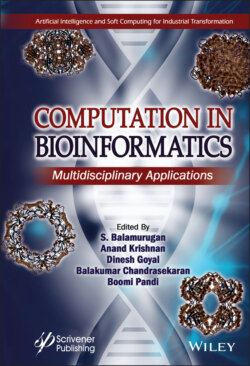Читать книгу Computation in BioInformatics - Группа авторов - Страница 26
1.4 Applications
ОглавлениеBioinformatics plays an important role in defining and classifying the nucleotide compositions of human genome sequence. This field helps in identifying and analyzing a large number of biological drug targets, thereby greatly increasing the possibility of potential drugs. This approach provides strategies and algorithm to predict new drug targets and also stores and control available drug target information. The annual expenditure of developing a new drug has been reduced due to the application of bioinformatics in drug discovery. They play a major role in determining the variation of species on the basis of similarity or dissimilarity of gene structure or amino acid sequence in protein. The level of sequence similarity can also be determined using bioinformatics analysis tools. Bioinformatics techniques are mainly applied in two different phases of drug discovery. First is extracting interesting information. Second is finding important genes and proteins, thereby speeding the process of drug discovery.
Genome sequencing of various organisms has become possible due to bioinformatics. There are almost hundred organisms whose genome has been mapped so far using bioinformatics tools [48]. The databases of these organisms are increasing day by day as every day a new information about any organism. Bioinformatics and genomics have been adopted by pharmaceutical industries for drug targets and drug discovery. The possibility of designing and developing drugs is due to the understanding of molecular biology with the help of bioinformatics tools. In the recent years, bioinformatics has made it easier for the researchers to easily target the molecules in the in vitro environment. Screening of newly developed compounds can now be done against the molecules of the proteins or genetically modified cells thereby giving efficient results. This way of drug development has made the process of identification of the disease easier in an organism.
Several studies have been carried which highlights the role and application of bioinformatics tools in drug designing. Some of these are as follows.
In 2013, an investigation was done to evaluate the activity of anti-dengue in compounds that are isolated from eight Carica papaya [49]. It was investigated against NS2B-NS3 protease of dengue 2 virus (DENV-2). In this study, admetSAR was used to screen the ADMET properties of the compounds extracted from Carica papaya [49].
In 2014, molecular dynamics study was carried out to evaluate the constancy of the complexes of protein-ligand and individual protein. The study was also carried out for double mutant (toho-1-R274N/R276N in Escherichia coli) and triple mutant (toho-1-E166A/R274N/R276N in Escherichia coli) systems of class A β-lactamases and also for point mutant (SHV-E166A in Klebsiella pneumoniae) [50].
In 2014, to reveal the potential anti-mycobacterium activity of pyrrole hydrazine derivatives which acts on enoyl-acyl carrier protein reductase was carried out using CoMFA and CoMSIA analysis [51].
In 2016, Malathi and Ramaiah performed structure-based virtual screening to analyze the inhibtors that are potential for OXA-10 ESBL expressing P. aeruginosa. This was done in opposition to millions of compounds that are present in ZINC database. For this study, Molinspiration tool was used. The tool was used to filter the imipenem analogs that is based on the Lipinski’s rule of five [52].
In 2016, identification of novel inhibitors for Penicillin binding protein 2a (PBP2a) of ceftaroline-resistant methicillin-resistant Staphylococcus aureus (MRSA) was used for virtual screening using Dock blaster server [53].
Acinetobacter baumannii (A. baumannii), a Gram negative, coccobacilli which is associated with nosocomial infections has developed resistance to all known classes of antibiotics. The infections have been treated with the carbapenem group of antibiotics like imipenem and meropenem. According to the reports, A. baumannii has obtained resistance to imipenem due to the secretion of carbapenem hydrolysing class D betalactamases (CHDLs). A study was carried out in 2016, to search for the possible mechanism of imipenem resistance in OXA-143 and OXA-231 (D224A) CHDLs expressing A. baumannii. This was performed using molecular docking and dynamics simulation studies.
Malathi et al., in 2016, carried out a study to find the possible mechanism of imipenem resistance in OXA-143 and OXA-231 (D224A) CHDLs expressing A. baumannii by implementing molecular docking and dynamics study. Their study revealed that OXA-143 CHDL-imipenem complex has better binding affinity than OXA-231 (D224A) CHDL-imipenem complex. Their results also indicated that binding affinity of OXA-143 with imipenem was strong when compared with OXA-243. Hence, they could conclude that this mechanism might be the probable reason for imipenem resistance in OXA-143 expressing A. baumannii strains [54].
In 2017, Suganya et al. investigated the anti-dyslipidemic property. This property was studied on plant compounds against HMG-CoA reductase. Molecular dynamic study was performed to analyze the stability of the rutin-HMG CoA complex. It was observed that the resulted plots reveal the constancy of the Epicatechin-HMG CoA complex instead of the free HMG CoA [55].
In 2018, Kist et al. have performed a search which was ligand-based Pharmacophore in order to investigate non-ATP competitive inhibitors for mammalian or mechanistic target of rapamycin (mTOR).
The spatial arrangement of protein model and ligand model was generated in order to design a model by ZINCPharmer platform.
This was done with the help of hydrophobic interactions of residues like C19, C5, C21, C45, C43, and C49 of rapamycin. Thus, it results in the generation of eight new inhibitors with better activity [56].
